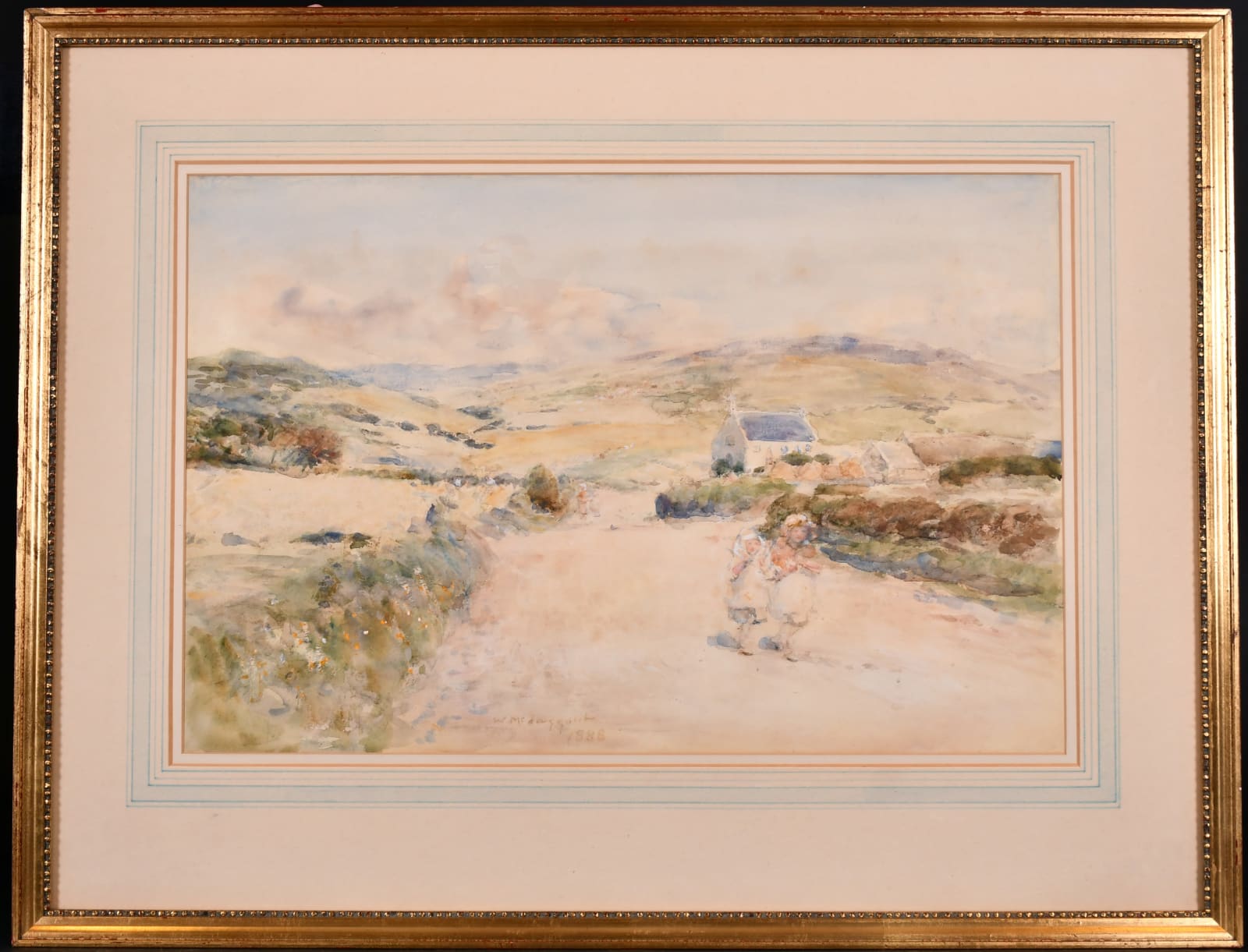William McTaggart RSA RSW
The Village Church
Watercolour
Size without frame 13 1/4 x 20 ins
Size with frame
Size with frame
£ 2,500.00
Further images
Born Aros, near Campbelltown, Argyll, died Dean Park, Broomieknowe, Midlothian April 2. Son of a crofting family. As a boy was first apprenticed to a chemist in Campbelltown but left home at 16 and went to Edinburgh. His childhood days on the Mull of Kintyre induced a love of the sea that stayed with him for the rest of his life. In Edinburgh he trained at the Trustees Academy under Scott Lauder 1852-1859. Among his contemporaries were Hugh Cameron, George Chalmers, Tom Graham and John Pettie. Began exhibiting at the age of 18 and won several prizes as a student, obtaining portrait commissions in his early days. His first exhibits were all portraits. By 1857 he decided to concentrate entirely on landscapes and figure subjects limiting himself to portraits, mainly of children, only when he badly needed money. A pre-Raphaelite approach was evident in his early landscapes, it is said he spent three months painting one particular view on Kintyre. These early works were predominantly anecdotal, a feature that gradually disappeared as he developed. After his marriage in 1863 he settled in Fairlie, near Largs. During the winter he worked on large oils, spending the summer sketching on the coast. His "Grandmother Knitting' 1864, now in Glasgow AG, and 'Spring' (1864 NGS) are perhaps his most important works from this period. By 1860 his interest in impression and mood was overtaking his interest in detail, and his lack of 'finish' was beginning to find criticism. His diploma work illustrating a scene from Tennyson's Dora 1868/9 illustrate this transition while further development can be seen in 'On the White Sands' painted two years later, now in Broughty Ferry AG. In 1868 he painted on Loch Fyne with Colin Hunter. Irwin has commented that the fluency of his swiftly executed watercolours influenced the loosening of his handling of oil paint, a new found freedom which burst into a more turbulent, aggressive view of nature in the 1880s. About this time he began to use rougher canvasses with more dramatic compositions. In 1883 he introduced the idea of completing a work in only one session, thus his 'Carradale' 1883, now in Kirkcaldy AG. On this was based a larger stormy canvas (1890) purchased by Andrew Carnegie. From 1876 he painted 'On the Atlantic Shore' at Machrihanish and after 1889 moved from Edinburgh to Broomieknowe, Midlothian where he spent the rest of his life, although continuing to regularly visit the coast. In later work there is a weakness in his handling of form, especially human figures. The broken colour surfaces of the children dissolve into their surroundings and whilst this is all part of portraying the unity of man with nature, it is never entirely successful and the great praise lavished upon his work during his lifetime seems now perhaps a little exaggerated. Nevertheless his voyage into impressionism certainly hastened the development of Scottish art in this direction and helped delineate the battle lines for the surging Glasgow School. Hardie believes that even Turner did not excel McTaggart in the latter's knowledge of swift movement, 'the scudding foam and spray, the changing light and colour of the sea'. For his main biographer and protagonist Caw, he painted the sea ' with a passion and insight, a profound knowledge of Nature and an assured mastery if expression, which makes him incomparable. Other men paint the form and colour of the sea, he expresses its apparent life', and, in the Art Journal, 'a pitcure such as 'Storm', surely one of the most wonderful renderings of the tumultuous agitation of a great elemental disturbance ever painted .. in variety, power, and originality he is the most imposing figure in Scottish art today, and one of the few great artists of our time'. McTaggart's work remains of seminal importance, not only because of its influence upon succeeding generations of Scottish artists, but also because of its unique qualities.
Elected ARSA 1859, RSA 1870, 'Harvest Moon' (1899) was purchased by the Chantrey Bequest. Friendship with Sam Bough was instrumental in arousing an interest in watercolours and in 1878 he was elected President of the newly formed Society of Scottish Watercolour Painters. Grandfather of William MacTaggart.Exhibited 107 works at the RSA between 1855 and 1911, eight works at the RaA 1866-1875, and RHA, RSW, GI (100+), AAS, and L (10). Represented in the Tate AG, NGS, SNPG (Self Portrait), Aberdeen AG, Broughty Ferry AG, Glasgow AG, Kirkcaldy AG, Paisley AG, Perth AG, RSA, Edinburgh City collection (6), Brodie Castle (NTS), Sydney AG (Australia), Nat Gall of Canada (Ottawa).
Elected ARSA 1859, RSA 1870, 'Harvest Moon' (1899) was purchased by the Chantrey Bequest. Friendship with Sam Bough was instrumental in arousing an interest in watercolours and in 1878 he was elected President of the newly formed Society of Scottish Watercolour Painters. Grandfather of William MacTaggart.Exhibited 107 works at the RSA between 1855 and 1911, eight works at the RaA 1866-1875, and RHA, RSW, GI (100+), AAS, and L (10). Represented in the Tate AG, NGS, SNPG (Self Portrait), Aberdeen AG, Broughty Ferry AG, Glasgow AG, Kirkcaldy AG, Paisley AG, Perth AG, RSA, Edinburgh City collection (6), Brodie Castle (NTS), Sydney AG (Australia), Nat Gall of Canada (Ottawa).
Join our mailing list
McEwan Gallery Newsletter
* denotes required fields
We will process the personal data you have supplied in accordance with our privacy policy (available on request). You can unsubscribe or change your preferences at any time by clicking the link in our emails.





